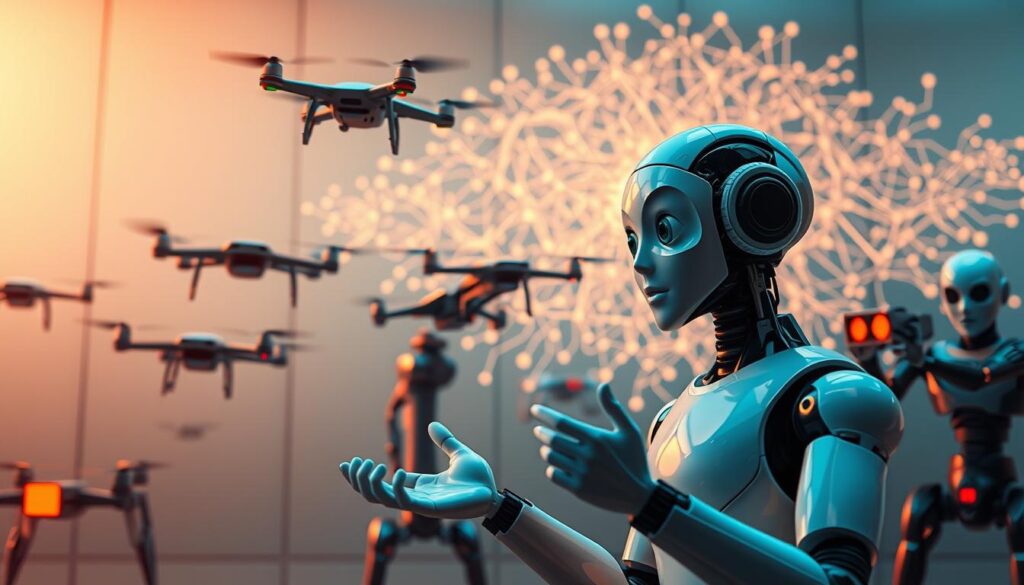“We can only see a short distance ahead, but we can see plenty there that needs to be done.” – Alan Turing. This quote captures the essence of today’s technological advancements, where autonomous programs are reshaping industries and redefining possibilities.
From basic chatbots to sophisticated systems, these programs have evolved significantly. They now monitor environments, make decisions, and act independently, reducing human intervention. Their ability to integrate with external tools and databases ensures real-time updates, enhancing their efficiency.
In fields like healthcare, business, and emergency response, their impact is profound. For instance, they boost productivity by 50% in software development and reduce production errors by the same margin1. Companies leveraging these tools often outperform competitors, creating a significant performance gap1.
As technology advances, the integration of large language models (LLMs) and large action models (LAMs) is accelerating. Future developments focus on enhancing memory, reflection, and user experience, ensuring more personalized interactions2.
Key Takeaways
- Autonomous programs monitor environments and act independently.
- They integrate with external tools for real-time updates.
- Productivity in software development increases by 50%1.
- Future advancements focus on memory and user experience2.
- Their impact spans healthcare, business, and emergency response.
Introduction to AI Agents and Their Capabilities

The evolution of autonomous programs has transformed how tasks are handled across industries. These systems, often referred to as AI agents, leverage advanced language models to process inputs and execute actions independently. Their ability to integrate with external tools and databases ensures seamless performance in complex workflows3.
AI agents perceive user inputs through natural language processing, enabling them to understand and respond effectively. This step-by-step approach allows them to break down complex goals into manageable subtasks, optimizing efficiency4. For instance, they can automate routine processes like expense reporting or inventory management, reducing human effort significantly5.
Decision-making is a critical aspect of these systems. By analyzing data and selecting appropriate actions, they ensure accurate and timely results. Recent advancements, such as memory infrastructure, enhance their ability to maintain context across interactions, improving user experience3.
Integration with external tools further expands their capabilities. For example, Microsoft 365 Copilot allows users to create and publish agents without coding skills, democratizing access to this technology3. Such innovations set the stage for broader applications in business, healthcare, and beyond.
In summary, AI agents are reshaping how tasks are approached, offering efficiency, accuracy, and scalability. Their ability to process inputs, make decisions, and integrate with tools positions them as indispensable assets in modern workflows.
The Fundamentals of AI Agents: Core Concepts and Types

Understanding the core principles behind intelligent systems is essential for grasping their potential. These systems, often referred to as intelligent agents, rely on foundational mechanisms to process inputs and execute tasks. Their ability to adapt and learn makes them invaluable across industries.
Defining Intelligent Agents
An intelligent agent is a system designed to perceive its environment and take actions to achieve specific goals. These systems vary in sophistication, from simple rule-based programs to advanced models capable of learning and decision-making. For example, they can analyze large datasets quickly, improving decision-making processes6.
Core components include sensors for data collection, internal models for processing, and mechanisms for accumulating historical data (datum). These elements work together to enhance functionality and accuracy7.
Key Components and Mechanisms
Intelligent agents rely on a combination of hardware and software to function effectively. Sensors gather real-time information, while internal models interpret this data to guide actions. Historical data accumulation allows these systems to refine their responses over time, improving performance6.
Behind every intelligent agent is a dedicated team of developers and engineers. Their efforts ensure the system’s knowledge base remains up-to-date and relevant. This collaboration is crucial for creating systems that meet specific customer needs7.
Different types of agents exist, each with unique operational rules. Simple reflex agents respond to immediate inputs, while learning agents adapt based on past experiences. These variations enable diverse applications, from customer service to healthcare8.
In real-world scenarios, intelligent agents streamline workflows and reduce errors. For instance, they can handle thousands of queries instantly, eliminating wait times8. Their ability to operate 24/7 ensures consistent support, enhancing both efficiency and user satisfaction.
Exploring Types of AI Agents in Detail

Intelligent systems come in various forms, each designed to handle specific tasks efficiently. These systems are classified based on their design and capabilities, ranging from basic to highly advanced models. Understanding these types helps in identifying the right system for specific applications.
Simple Reflex and Model-based Reflex Agents
Simple reflex systems operate on pre-programmed rules, responding directly to immediate inputs. They require minimal computational resources, making them quick and efficient for straightforward tasks9. For example, they are often used in automated light switches or basic chatbots.
Model-based reflex systems, on the other hand, maintain internal models of their environments. This allows them to adapt to dynamic conditions, making them more versatile than simple reflex systems9. They are ideal for applications like traffic management, where conditions change frequently.
Goal-based, Utility-based, and Learning Agents
Goal-based systems focus on achieving specific objectives. They use search and planning algorithms to prioritize tasks effectively9. For instance, they are commonly used in robotics and navigation systems to reach predefined destinations.
Utility-based systems evaluate the quality of outcomes to maximize utility. They are essential for complex decision-making, such as resource allocation or scheduling9. These systems ensure optimal results by comparing multiple options.
Learning systems improve over time by analyzing data and recognizing patterns. They adapt their strategies based on feedback, making them highly effective in unpredictable environments10. Examples include recommendation engines and fraud detection systems.
Each type of system has unique strengths, making it suitable for specific scenarios. By leveraging these capabilities, industries can enhance efficiency and achieve their goals more effectively. For more insights on how these systems are transforming industries, explore AI in business.
Hierarchical and Multi-agent Systems: Structuring Complex Tasks

Complex tasks often require structured approaches, and hierarchical systems provide the framework needed for efficient execution. These systems break down large objectives into smaller, manageable subtasks, ensuring smooth process flow and effective delegation11.
Organized Tiered Architectures
Hierarchical systems use tiered architectures to manage tasks at different levels. Higher-level agents oversee broader goals, while lower-level agents focus on specific actions. This structure enhances organization and ensures that each tool and resource is used effectively11.
For example, in search-and-rescue operations, a supervisor agent coordinates efforts across regions, while mid-level agents manage local operations. This division of labor improves efficiency and response time11.
Collaboration in Multi-agent Frameworks
Multi-agent systems excel in scenarios requiring collaboration. These frameworks allow specialized agents to work together, sharing information and synchronizing efforts. Effective communication ensures that all agents align with common objectives12.
In disaster response, agents can analyze weather patterns, coordinate rescues, and monitor supplies simultaneously. This teamwork enhances overall performance and accuracy11.
Decentralized networks further improve robustness. If one agent fails, the system continues functioning, ensuring uninterrupted process flow12.
Hierarchical and multi-agent systems are transforming how complex tasks are managed. By leveraging structured architectures and collaborative frameworks, these systems enhance efficiency, accuracy, and scalability in various applications.
Exploring: What can AI agents do?

Modern technology has unlocked new possibilities for automating tasks and making decisions with precision. These advanced systems are transforming how businesses operate, streamlining workflows, and enhancing overall performance.
Real-world Task Automation and Decision-making
AI agents excel at automating complex tasks, reducing the need for manual intervention. For example, they can handle repetitive processes like data entry or inventory management, freeing up human resources for more strategic activities13.
Decision-making is another area where these systems shine. By analyzing large datasets in real-time, they identify patterns and make informed choices. This capability is particularly valuable in industries like finance, where quick and accurate decisions are critical14.
AI agents also leverage performance metrics to refine their actions continuously. For instance, they can adjust strategies based on feedback, ensuring optimal results over time15.
Integration with External Tools and Data Streams
One of the most powerful features of AI agents is their ability to integrate with external tools and data streams. This allows them to access real-time information, enhancing their decision-making capabilities13.
For example, in customer support, AI agents can pull data from CRM systems to provide personalized responses. This integration reduces response times by up to 50%, significantly improving customer satisfaction14.
Organizations that adopt these systems often see a boost in workflow efficiency. By automating tasks and integrating data, they can focus on strategic goals, driving overall business success15.
To learn more about how AI agents are transforming industries, explore AI agents in business.
Enhancing Business and Customer Experience with AI Agents

Businesses are increasingly turning to advanced technologies to enhance efficiency and customer satisfaction. These systems streamline operations, reduce manual effort, and deliver personalized interactions, transforming how companies engage with their audience.
Automating Workflows and Improving Performance
AI agents excel at automating repetitive tasks, such as data entry and scheduling, freeing up human resources for strategic activities. By integrating with software tools, they ensure seamless application across workflows, boosting overall performance16.
For example, these systems can handle thousands of queries simultaneously, reducing response times by up to 50%. This efficiency allows businesses to focus on high-impact tasks, such as developing tailored solutions and building customer relationships17.
Personalized Customer Interactions
Using advanced language processing, AI agents deliver customized responses based on customer preferences and history. This personalization enhances engagement and satisfaction, as customers feel understood and valued16.
AI agents also resolve common problems independently, such as answering FAQs or guiding users through troubleshooting steps. This capability ensures that human agents can focus on more complex issues, improving overall service quality17.
By leveraging real-time data, these systems provide 24/7 support, ensuring assistance is always available. This availability significantly enhances customer experience and loyalty16.
To learn more about how AI agents are transforming customer interactions, explore AI agents in customer service.
Innovative Applications in Healthcare and Emergency Response
The integration of advanced technologies into critical sectors is reshaping how challenges are addressed. In healthcare and emergency response, these systems are proving indispensable, offering solutions that enhance efficiency and save lives.
Healthcare systems are leveraging automation to streamline processes and improve patient outcomes. For instance, diagnostic tools powered by artificial intelligence can improve accuracy by up to 20%, reducing errors significantly18. Predictive analytics also play a crucial role, cutting hospital readmission rates by 30% when implemented effectively18.
Personalized medicine is another area where these systems shine. By analyzing genetic data, they can tailor treatments, increasing efficacy by 50%18. Virtual health assistants handle up to 80% of routine inquiries, allowing healthcare professionals to focus on complex cases18.
Healthcare Automation and Treatment Planning
Automation in healthcare extends beyond diagnostics. Systems utilizing natural language processing reduce documentation time by 50%, freeing up providers for patient interaction18. Cognitive computing analyzes patient data 10 times faster than humans, enabling quicker decision-making18.
AI-driven decision support systems also improve adherence to clinical guidelines by 15%, ensuring better care standards18. These advancements not only enhance patient outcomes but also save the industry over $150 billion annually by 202618.
Deploying AI in Emergency and Rescue Operations
In emergency response, real-time data integration is critical. AI systems predict patient surges and optimize resource allocation, ensuring timely responses19. During disasters, these systems coordinate efforts, improving efficiency and accuracy18.
For example, in emergency medical dispatch, AI applications outperform traditional methods, increasing accuracy by 27%20. Tools like Medknowts reduce documentation keystrokes by 67%, allowing responders to focus on saving lives20.
User-centric design ensures these systems adapt to dynamic environments, providing reliable support when it matters most. By leveraging data-driven decision-making, they enhance both patient outcomes and operational efficiency19.
The Future of AI Agent Technology and Generative AI
The future of intelligent systems is being shaped by groundbreaking advancements in generative technology. Over 72% of companies are now deploying these solutions, highlighting their growing importance21. As systems evolve, they are transitioning from simple reflex agents to advanced learning agents, capable of integrating external resources and iterative feedback.
Emerging Trends and Advanced Architectures
Advanced architectures are redefining how systems operate. Companies like Adept and Imbue are developing multiagent frameworks that enhance collaboration and efficiency21. These systems streamline complex workflows, such as loan underwriting, reducing review cycle times by 20% to 60%21.
Foundation models are enabling seamless integration with existing tools, eliminating the need for extensive manual efforts21. This evolution is driving productivity and reducing costs, particularly in software development21.
Generative AI and Its Impact on Agent Autonomy
Generative technology is revolutionizing autonomy by enabling systems to handle diverse situations in real-time. These systems adapt dynamically, much like large language models, to prompts they haven’t been explicitly trained on21.
This capability enhances decision-making, allowing systems to execute complex workflows with precision. For example, they can automate tasks in online marketing campaigns, which traditionally require tedious coordination across tools21.
As generative systems continue to evolve, they will play a pivotal role in industries like finance, healthcare, and emergency response. Businesses that adopt these technologies will gain a competitive edge, while those that delay risk falling behind22.
Conclusion
Intelligent systems are reshaping industries by automating tasks and enhancing decision-making processes. These systems, often referred to as intelligent agents, leverage advanced intelligence to process input and execute actions efficiently. From healthcare to customer service, their applications are transforming how businesses operate and deliver experience.
As technology evolves, the integration of generative and utility-based functionalities is driving innovation. Intelligent agents are now capable of handling thousands of queries simultaneously, reducing manual effort and improving operational efficiency23. This adaptability ensures they remain relevant in dynamic environments, continuously refining their performance through feedback loops24.
Looking ahead, the focus will be on enhancing product development and operational scalability. By addressing challenges like overfitting and concept drift, these systems will become even more reliable23. The future promises a seamless blend of automation and human creativity, unlocking new possibilities across industries.
FAQ
What are the core components of intelligent agents?
How do utility-based agents differ from goal-based agents?
What role do multi-agent systems play in complex tasks?
How do AI agents integrate with external tools and data streams?
What are the benefits of using AI agents in customer interactions?
How is generative AI shaping the future of autonomous agents?
Source Links
- AI agents can reimagine the future of work, your workforce and workers
- Council Post: AI Agents: The Next Frontier In Intelligent Automation
- AI agents — what they are, and how they’ll change the way we work – Source
- What Are AI Agents? | IBM
- What Are AI Agents? Benefits, Examples, Types
- What Are AI Agents? Definition, Types, and How Intelligent Agents Work
- What is an AI agent?
- AI Agents Explained: The Essential Guide for Enterprise Success
- Exploring Different Types of AI Agents and Their Uses
- Types of AI Agents For (2025)
- Building Your First Hierarchical Multi-Agent System
- What is a Multiagent System? | IBM
- What are AI agents and why do they matter?
- AI Agents: 5 Types, Benefits, and Real-World Examples
- AI Agents Explained: The Future of Task Automation and Productivity
- Why AI Agents Are The Next Big Thing In Sales
- AI Agent-Led Customer Service: Revolutionizing Support with Freddy AI
- AI in Healthcare 2024 – Patient Care with Intelligent Agents
- How AI Agents Are Transforming Healthcare and Patient Care
- Artificial Intelligence in Emergency Medicine: Viewpoint of Current Applications and Foreseeable Opportunities and Challenges
- Why agents are the next frontier of generative AI
- Why AI Agents—Not ChatGPT—Will Dominate 2025
- How AI Agents Work: Unraveling the Mechanisms Behind Intelligent Automation
- What are AI Agents and How Do They Work? | Datadog







